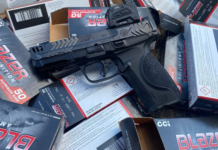Semi-automatic, also commonly referred to as auto-loading, is defined by two factors. The first is an energy induced method of extraction, ejection, and chambering of a subsequent round. The second is that a semi-automatic only fires one shot per ‘deliberate action’ of the trigger.
An automatic firearm, which is also autoloading, will fire rounds until the trigger/firing mechanism is released by the shooter.
This new trigger from Rare Breed certainly sits in a space between. We know that Echo and Binary triggers utilize the definition of semi-automatic to take advantage of the forward motion of the trigger as a deliberate action. This allows for a very rapid rate-of-fire by utilizing an otherwise unused action of the trigger.
But.. what if the trigger is mechanically forced to the reset point by the same mechanical method that trips the auto-sear in a select-fire AR-15. The ‘Forced Reset Trigger’ FRT-15 uses the geometry of the of a standard AR-15/M16/M4 bolt carrier to move the trigger forward to the reset point, coinciding with the point the bolt is safely closed and locked to fire another round.
Where an automatic/select-fire fire control auto-sear will release the hammer as the bolt closes and locks, an action independent of movement of the trigger, the FRT-15 uses that energy to push the trigger itself back to the reset point.
By design, the trigger must still be pulled to the rear deliberately to fire subsequent rounds. But the FRT-15 is mechanically adding an active trigger reset mechanic as part of the cycle of operations instead of keeping that mechanic separate of the operation cycle. Yes the trigger will still reset “automatically” because of the trigger spring, but because of the disconnector assembly in a standard or automatic trigger group the energy imparted by the bolt opening and closing is not imparted to the trigger in any manner to move it.
It is that active reset that will be the crux of an ATF determination for or against this trigger. BDU and Rare Breed clearly put some legal legs into the design but the ATF has chopped solid legal legs from beneath things before, the original MCX muzzle device comes to mind where you could purchase the simplified suppressor from SIG that threaded onto it and had the break become the baffle system.
From a pure mechanics standpoint this thing is very cool. The mechanical weak point theoretically exists in the fact that if the trigger is kept pulled too hard to the rear, you may be able to keep the rifle from going into battery. If there is a separating mechanic where enough pressure is exerted against the trigger it will still allow the closing of the bolt, I’m not seeing it in the video.
With that all said, I do expect this to trigger (hehe) another NFA fight and generate yet another reason why it should be chucked from law books into this history bin as a heavily flawed piece of legislation.



